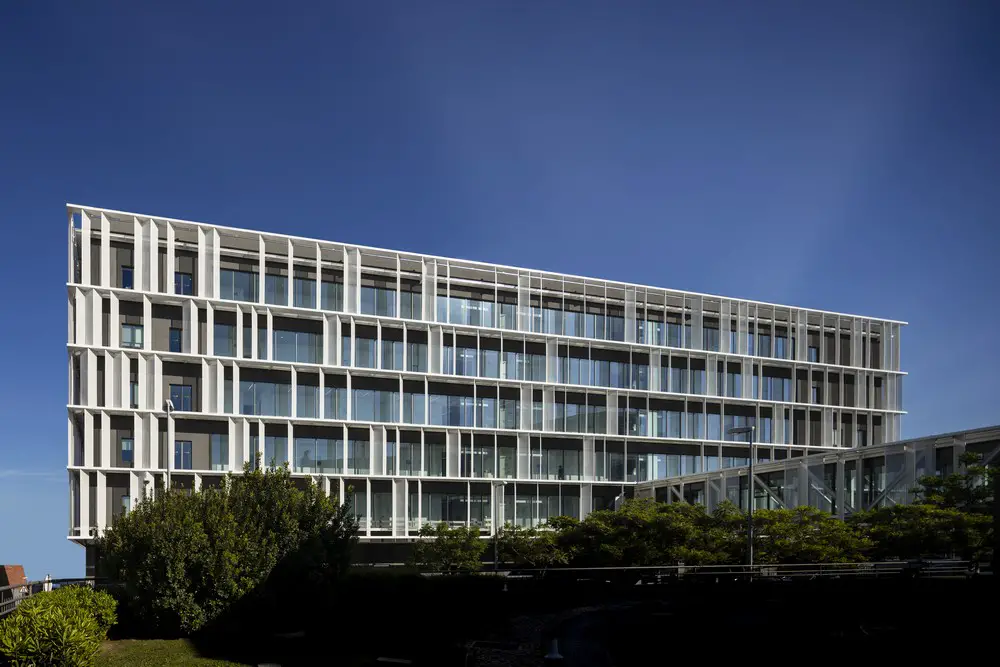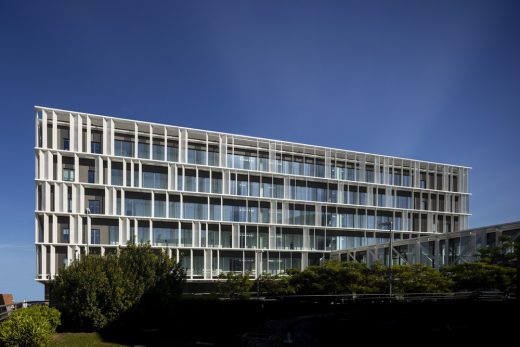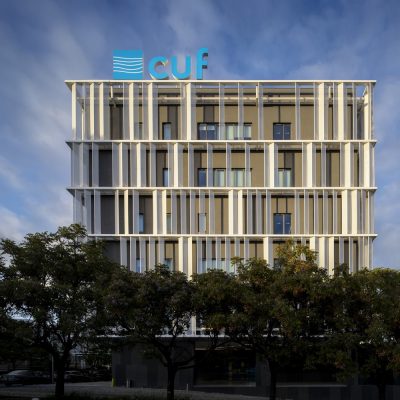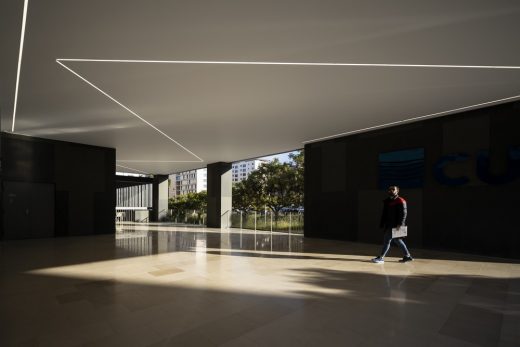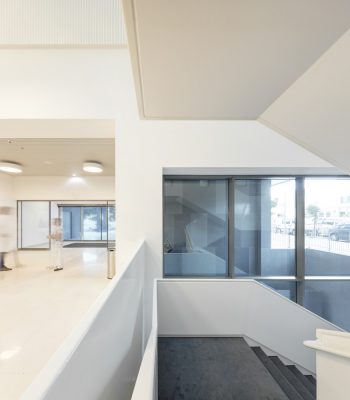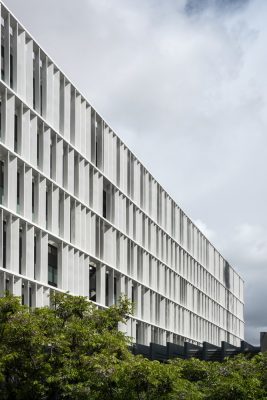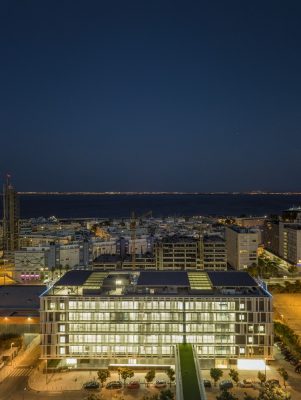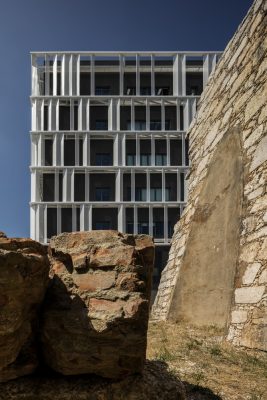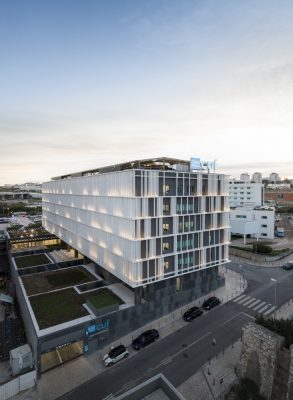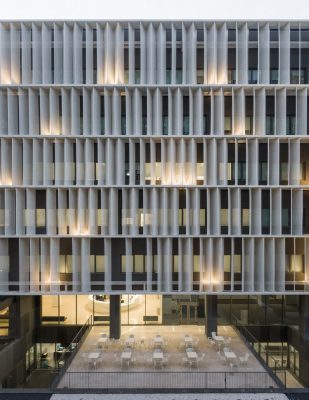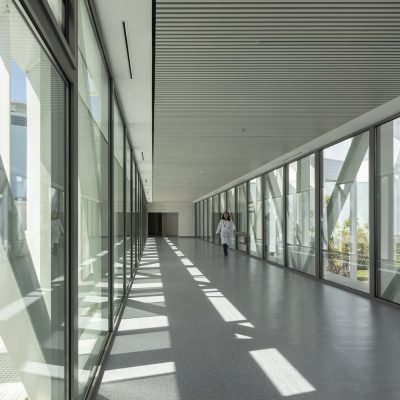Cuf Descobertas Hospital Portugal, Lisbon Health Building, Portuguese Architecture Images
Cuf Descobertas Hospital in Lisbon
16 Apr 2020
Design: IDOM
Location: Lisbon, Portugal
Photos by FG+SG
Cuf Descobertas Hospital
The construction of this new building was the consequence of the need to extend the Cuf Descobertas Hospital, property of the Jose de Mello Saude group. It works exclusively as an out-patient’s clinic, covering the majority of specialities of modern medicine.
Located in the Parque Das Nacoes in Lisbon, the original building, designed at the end of the 90s, marked the beginning of a new era in Portugal’s hospital design, introducing innovative criteria both in its functional distribution and, particularly, the promotion of a new hospital image in which healthcare premises would be made more comfortable and humane to patients and personnel.
The extension building had to respond to a complex set of programmatic and urbanistic requirements. More important however was the fact that it was being introduced in its essence, as a powerful “external device”, full of functional availability, stemming from its base like a cell that duplicates, not for reproduction, but rather to become whole, generating the idea of a “hospital campus”.
The design of the new extension building reflects that tension, resulting from the combined analysis of both buildings, from the architectural protagonism that they should each take on, from their specific functional interrelations and genetics, but at the same time looking for a base design that would appease the time difference that separates both construction times.
The formal character of the new Building 2 of the CUF Descobertas Hospital would have to be in line with this complex and sensitive balance. It had to guarantee, on the one hand, that the main building would be identified as a national referential social security and technological centre whilst at the same time, stating the new building’s architectural contemporaneity and the uniqueness of its exclusive out-patient usage, developing as a new wing organised and extended from the pre-existing hospital to shelter and embrace the out-patient’s clinic activity, opening up to the city one of the main access doors of the hospital complex.
With simple and regular shapes, determined by the planning conditions of the plot, the new building intends to express its own identity, sober and compact, based on the direct link between the building and its purpose and the rational use of materials.
Just like the main building’s project back in its day, the design of this new block meant to be used exclusively by out-patients, includes revolutionary aspects that represent radical changes in the concepts of hospital comfort, sustainability and energy efficiency in this type of building.
The building was conceived in a multidisciplinary fashion by IDOM architects and engineers in order to achieve the highest possible functional efficiency and high environmental comfort standards while at the same time ensuring it could behave, during its exploitation, as a nZEB – nearly Zero Energy Building – which is to say, that it would consume little more energy than what it could generate through renewable energy sources, considered over a whole year period.
Meeting these goals and knowing beforehand that hospitals, due to their functional essence, are big energy consumers, called for the implementation of solutions never before considered in hospital designing, making the most of the firm’s multidisciplinary nature and getting all the project specialists involved from the early stages of design, defining a set of design strategies, classified according to their importance which in turn were linked to their impact on the end result.
A double skin façade was designed. It was made up of triangular metal elements, their angles compensating the bad orientation of the plot. These vertical elements have micro-perforations in varying perforation concentrations according to the solar radiation and the amount of sunlight required in the working areas.
The amount and distribution of these pieces as well as the perforation percentage of each one was calculated and determined for each individual point of the different elevations, using advanced energy and lighting simulation models.
This façade, along with the use of passive and semi-passive HVAC systems never before used in hospitals in the Iberian peninsula, have definiteively contributed to the very positive results in terms of comfort and energy efficiency, without disregarding the architectural image which was to be attractive and referential within the built-up surroundings of the most modern area in the city of Lisbon.
To complement the design strategies agreed by architects and engineers at Idom, for the construction of a nearly Zero Energy Building, it was necessary to go beyond conventional, already-tested solutions. We worked with the building’s thermal inertia as a basic part of the HVAC system.
For this purpose, the building’s thermal inertia was magnified and controlled through the thermal activation of the concrete structural slabs (TABS), a system that, along with all the other design strategies, allowed for the significant reduction in importance of the hospital’s air conditioning, limiting its role almost exclusively to the necessary air renewal.
Programme wise, the building has 150 surgeries and 30 examination rooms, 2 same-day surgery operating theatres and a medical training area that includes an auditorium with a capacity for 150 people.
The medical programme occupies 11,200 built-up square metres and the underground car park 11,810 m2. The hospital is organised into speciality clusters following a scheme that offers great construction and functional flexibility, keeping the hospital’s people flow well defined.
The areas taken up by the different specialities are the following:
Cardiology – 408 m2; orthopaedics – 982 m2; radiology – 332 m2; Women’s clinic – 1,052 m2; various specialities – 453 m2; Paediatrics – 735 m2; surgical specialities – 453 m2; stomatology – 385 m2; immunology – 495 m2; otorhinolaryngology – 424 m2; respiratory department – 44 m2; same-day surgery (operating theatres) – 357 m2; ophthalmology – 667 m2; dermatology – 438 m2; reconstructive plastic surgery – 34 m2; training
Cuf Descobertas Hospital, Lisbon – Building Information
Studio: IDOM
Client: Imo Health – Investimentos Imobiliários, Unipessoal Lda.
Location: R. Mário Botas, 1998-018 Lisboa, Portugal
Area: 23.010 sqm
Head Architect: Rui Maia
Architects:
Rui Maia
Jorge Matias
João Santos
Javier Díaz
Laura Valcarcel
Magdalena Ostornol
María Del Pino
Pablo Viña
Costs: Carmen Camarno
Structures:
Carlos Castañon
Pedro Viegas
David García
Romina González
Hydraulic Building Services:
António Cardoso Gaspar
Susana Maduro
Fire Safety: Belén Herrero
Hvac:
Ramón Gutierrez
José Sereno
Isaac Lorenzo
Javier Sánchez
Antonio Mendoza
Energy Efficiency And Sustainability:
Ramón Gutierrez
Javier Martín
Energy Performance Certificate: Ana Rita Henriques
Electricity Building Services:
Luís Barra
Joao Parreira
Technical Management: Luís Barra
Voice And Data/telecommunications:
Asís Hernando
Inés Horta
Special Building Services (Medicinal Gases, Pneumatic Tube Transport):
Julio César García
Carmén Vieira
Acoustics:
Mario Torices
Odete Domingues
Office Clerks:
Vanesa Marrero Castro
Isabel Cantero Murillo
Construction Stage Technical Coordination:
António Cardoso Gaspar
Carmén Vieira
António Jorge Matias
Belén Herrero
Pedro Viegas
Luís Barra
Inês Cardoso
José Sereno
Interior Design: P-06 Atelier
Computer Graphics: Manuel Leira Carmena
Year: 2016 (Project) 2018 (Construction)
Photography: Fg+sg
Cuf Descobertas Hospital in Lisbon, Portugal images / information received 160420 from IDOM
Location: Lisboa, Portugal
Portuguese Architecture
New Portuguese Buildings
Portugal Architecture Design– chronological list
Architects: STUDIOARTE
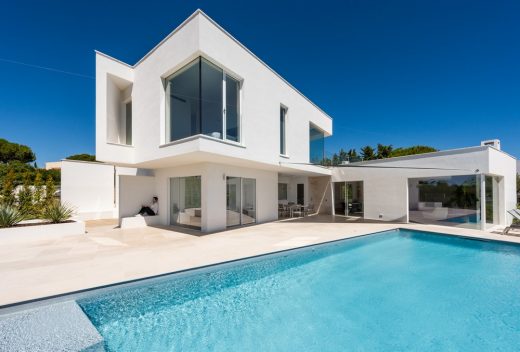
photography : Da Cruz Photo – Luís da Cruz
New House in Algarve
Design: Architects: Correia/Ragazzi Arquitectos
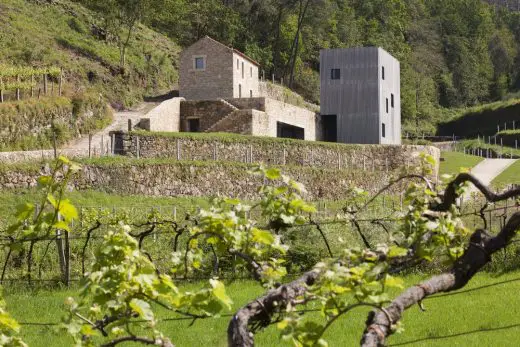
photograph : Juan Rodriguez
Alvarinho Houses in Melgaço
Design: Filipe Saraiva
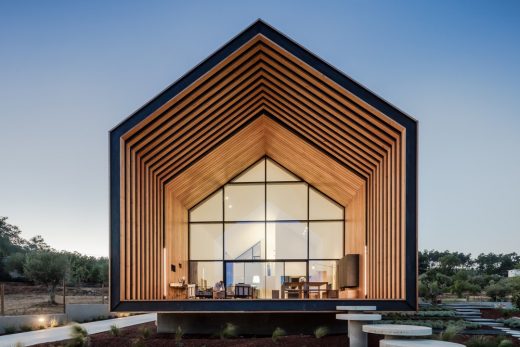
photo : João Morgado, Fotografia de Arquitectura
House in Ourém
Design: Pedro Henrique Arquiteto
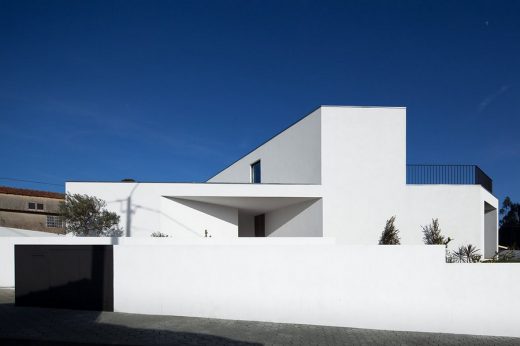
photograph : José Campos
Arrifana House
Design: Fran Silvestre Arquitectos
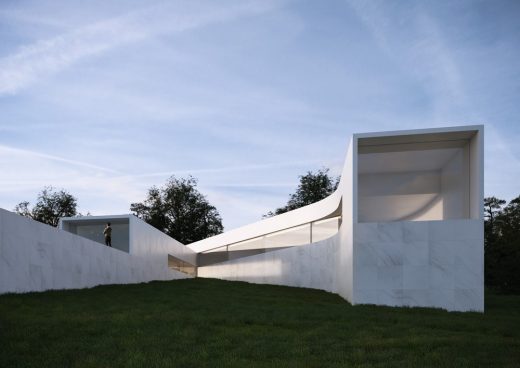
picture from architects office
Contemporary House in Lisbon
Comments / photos for the Cuf Descobertas Hospital in Lisbon Portugal building design by IDOM page welcome

